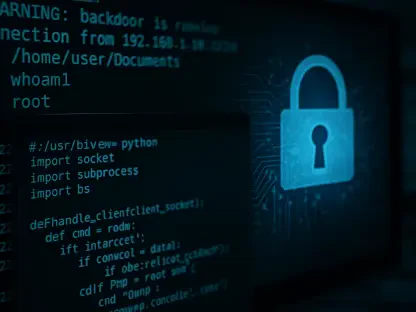In an era where digital communication forms the backbone of both business and personal interactions, a disturbing trend has emerged that threatens the very foundation of email security with cunning precision, as cybercriminals unleash sophisticated phishing attacks. These attacks are disguised as internal spam filter alerts or corporate “Secure Message” notifications, designed to trick users into surrendering their email credentials. These deceptive emails exploit the inherent trust people place in familiar corporate formats, posing a significant challenge to even the most vigilant individuals. Reports from threat intelligence teams highlight the rapid evolution of this campaign, noting its alarming complexity and professionalism. As attackers refine their methods to mimic legitimate processes, the risk of falling victim to such scams grows exponentially. This pressing issue demands a closer look at how these phishing attempts operate, the advanced techniques behind them, and the critical steps needed to safeguard against this growing menace in the digital landscape.
Unveiling the Deceptive Design of Phishing Alerts
A striking feature of this latest phishing campaign is the meticulous design of the emails, crafted to appear as authentic corporate communications with uncanny accuracy. These messages often claim that legitimate emails are delayed due to a supposed security system upgrade, complete with generic subject lines and timestamps to reinforce their credibility. A prominent “Move to Inbox” button serves as the bait, leading unsuspecting users through trusted domains before redirecting them to malicious phishing sites. This clever use of reputable brand URLs helps bypass traditional security filters, as recipients are less likely to suspect foul play when encountering familiar web addresses. The level of detail in these emails underscores the lengths to which attackers will go to deceive their targets, exploiting the natural inclination to trust notifications that resemble standard workplace correspondence. As a result, even cautious users may find themselves questioning the authenticity of such alerts only after it’s too late.
Beyond the surface-level deception, the redirection process reveals a calculated strategy to evade detection and maximize impact. Once clicked, the seemingly harmless button guides users through a series of redirects, often involving well-known domains that add a layer of legitimacy to the journey. The final destination, however, is a fraudulent site hosted on obscure, malicious domains that are frequently updated to avoid blacklisting. Security researchers have noted that these domains are quickly blocked once identified, but the speed at which new ones are created keeps defenders on the back foot. This cat-and-mouse game highlights the adaptive nature of cybercriminals, who continuously tweak their approach to stay ahead of conventional security measures. The exploitation of trusted web infrastructure in this manner not only amplifies the success rate of these phishing attempts but also erodes confidence in the digital systems relied upon daily, necessitating a deeper understanding of how such threats operate.
Technical Sophistication Behind Phishing Portals
Delving into the technical underpinnings of these phishing attacks reveals a level of sophistication that sets them apart from earlier, more rudimentary scams. Upon reaching the fraudulent site, victims are greeted with a personalized login form, often prefilled with their email domain through encoded parameters embedded in the phishing link. This customization, combined with branding specific to the targeted organization, creates a convincing illusion of authenticity. Unlike traditional phishing pages that rely on basic data collection methods, this campaign employs WebSocket connections for real-time credential theft. This technology enables continuous, encrypted communication between the user’s browser and the attacker’s server, allowing immediate capture of sensitive information. Such advanced tactics, paired with obscured JavaScript and dynamically loaded code, make it incredibly difficult for standard security tools to detect and block these threats in time.
Further complicating the defense landscape is the infrastructure supporting these phishing operations, which includes a network of malicious subdomains and servers designed to evade tracking. These supporting elements are often hosted on lesser-known platforms that are quickly abandoned and replaced once exposed. The real-time interaction facilitated by WebSockets also allows attackers to prompt users for additional information, such as two-factor authentication codes, enhancing the depth of data theft. This dynamic approach contrasts sharply with static phishing pages of the past, signaling a shift toward adaptive, automated deception. The growing complexity of these portals underscores the urgent need for updated security protocols that can keep pace with such innovative methods. As cybercriminals leverage cutting-edge technology to refine their attacks, organizations must prioritize advanced detection systems and user education to mitigate the risk of compromise in an increasingly hostile digital environment.
Evolving Trends in Cybercriminal Tactics
The broader trend illuminated by this phishing campaign is the shift from generic, scattershot attacks to highly personalized and automated deception strategies. Cybercriminals are increasingly relying on data-driven methods to tailor their phishing emails, ensuring they resonate with specific targets by mimicking internal communication styles. The use of persistent channels like WebSockets for real-time data capture indicates a move toward tactics that adapt on the fly, responding to user inputs with alarming precision. This evolution reflects a growing sophistication among attackers, who are no longer content with casting a wide net but instead focus on precision strikes that exploit human psychology and trust. Researchers agree that this trend represents a significant challenge to modern email security, as traditional defenses struggle to keep up with the pace of innovation in cybercrime, pushing the boundaries of what constitutes a detectable threat.
Another dimension of this evolving landscape is the sheer speed at which phishing campaigns adapt to countermeasures, rendering static security solutions less effective. As soon as one malicious domain is blocked or a phishing kit is identified, attackers deploy new infrastructure or tweak their code to bypass detection. This rapid iteration is fueled by a deep understanding of security protocols and user behavior, allowing cybercriminals to exploit gaps in awareness and technology with ruthless efficiency. The reliance on trusted domains as part of the redirection process further complicates efforts to filter out malicious content, as legitimate URLs are weaponized to lower suspicion. This persistent adaptability serves as a stark reminder that defending against phishing requires a dynamic, multi-layered approach that evolves as quickly as the threats themselves, ensuring that both technological and human defenses remain robust in the face of relentless innovation.
Strengthening Defenses Through Awareness and Tools
Amid the growing complexity of phishing attacks, human vigilance remains the cornerstone of effective defense, particularly when scams are designed to exploit trust in familiar formats. Employees and individuals must approach unexpected notifications about “delivery reports” or “pending messages” with a healthy dose of skepticism, verifying their authenticity by accessing email platforms directly rather than clicking on embedded links. Simple yet powerful practices, such as scrutinizing sender domains and hovering over hyperlinks to reveal their true destinations, can prevent many phishing attempts from succeeding. Additionally, enabling multi-factor authentication adds a critical layer of protection, ensuring that even if credentials are compromised, unauthorized access is significantly harder to achieve. Cultivating a culture of caution around digital interactions is essential to counter the psychological manipulation at the heart of these attacks.
Complementing human awareness with technological safeguards offers a more comprehensive shield against phishing threats. Tools like password managers, which refuse to autofill credentials on spoofed pages, serve as an early warning system for fraudulent sites. Similarly, web protection software can block harmful redirects before they reach their malicious destinations, disrupting the phishing chain at a critical juncture. Security teams are also encouraged to deploy advanced email filtering solutions that analyze message content and sender behavior for anomalies, catching sophisticated phishing attempts that slip through traditional defenses. By combining user education with cutting-edge tools, organizations can build a resilient framework that addresses both the human and technical vulnerabilities exploited by cybercriminals. This dual approach is vital to staying ahead of attackers who continuously refine their methods to bypass even the most stringent security measures.
Reflecting on a Path Forward
Looking back, the intricate phishing campaign that disguised itself as spam alerts stood out as a stark warning of how far cybercriminal tactics had advanced, blending seamless deception with technical prowess. The use of personalized login forms, real-time data theft through WebSockets, and trusted domain exploitation demonstrated a level of sophistication that caught many off guard. Security experts emphasized that the rapid adaptation of these attacks, marked by obscured code and dynamic infrastructure, demanded an equally agile response from defenders. The campaign’s success in mimicking corporate communications exposed critical gaps in user awareness and conventional security tools, prompting a renewed focus on proactive measures. Moving forward, the lessons learned underscored the importance of fostering a zero-trust mindset, integrating advanced detection systems, and prioritizing ongoing education to combat the ever-evolving landscape of email threats with unwavering determination.









